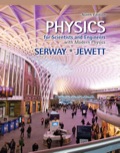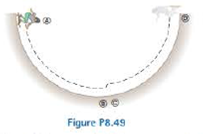
A skateboarder with his board can be modeled as a particle of mass 76.0 kg, located at his center of mass (which we will study in Chapter 9). As shown in Figure P8.49, the skateboarder starts from rest in a crouch-ing position at one lip of a half-pipe (point Ⓐ). The half-pipe is one half of a cylinder of radius 6.80 m with its axis horizontal. On his descent, the skateboarder moves without friction so that his center of mass moves through one quarter of a circle of radius 630 m. (a) Find his speed at the bottom of the half-pipe (point Ⓑ (b) Immediately after passing point Ⓑhe stands up and raises his arms, lifting his center of mass from 0.500 in to 0.950 m above the concrete (point ©). Next, the skateboarder glides upward with his center of mass moving in a quarter circle of radius 5.85 m. His body is horizontal when he passes point Ⓓ, the far lip of the half-pipe. As he passes through point Ⓓ, the speed of the skateboarder is 5.14 m/s. How much chemical potential energy in the body of the skateboarder was converted to mechanical energy in the skateboarder—Earth system when he stood up at point Ⓑ? (c) How high above point Ⓓ does he rise? Caution: Do not try this stunt yourself without the required skill and protective equipment.

Figure P8.49
(a)
The speed at the bottom of the half pipe.
Answer to Problem 8.49AP
The speed at the bottom of the half pipe is
Explanation of Solution
Given info: The mass of the particle is
The formula to calculate the initial gravitational potential energy of the particle at point
Here,
Thus, the initial gravitational potential energy of the particle at point
The formula to calculate the gravitational potential energy is,
Here,
The height of the particle at point
Substitute 0 for
Thus, the gravitational potential energy at point
The formula to calculate the initial kinetic energy of the particle is,
Here,
The initial velocity of the particle is 0 as the particle is at rest then the kinetic energy at point
Substitute 0 for
Thus, the kinetic energy of the particle at point
The formula to calculate the kinetic energy of the particle at point
Here,
Thus, the kinetic energy at point
The formula to calculate the law of conservation of energy is,
Here,
Substitute
Substitute
Rearrange the above formula for
Substitute
Conclusion:
Therefore, the speed at the bottom of the half pipe is
(b)
The amount of chemical potential energy converted into mechanical energy in the skateboarder- Earth system when he stood up at point
Answer to Problem 8.49AP
The amount of chemical potential energy converted into mechanical energy in the skateboarder- Earth system when he stood up at point
Explanation of Solution
Given info: The mass of the particle is
The formula to calculate the centripetal acceleration of the particle at the point
Here,
Substitute
Thus, the centripetal acceleration of the particle at point
The formula to calculate the normal force acting on the particle at point
Here,
Substitute
Thus, the value of normal force acting on the particle at point
The formula to calculate the chemical energy of the skateboarder converted into mechanical energy at point
Here,
Substitute
Conclusion:
Therefore, the amount of chemical potential energy converted into mechanical energy in the skateboarder- Earth system when he stood up at point
(c)
The height above point
Answer to Problem 8.49AP
The height above point
Explanation of Solution
Given info: The mass of the particle is
The formula to calculate the initial gravitational potential energy of the particle at point
Here,
Thus, the initial gravitational potential energy of the particle at point
The formula to calculate the gravitational potential energy is,
Here,
Thus, the gravitational potential energy at point
The formula to calculate the initial kinetic energy of the particle is,
Here,
Thus, the kinetic energy of the particle at point
The formula to calculate the kinetic energy of the particle at point
Here,
Thus, the kinetic energy at point
The formula to calculate the law of conservation of energy is,
Here,
Substitute
Substitute
Substitute
Conclusion:
Therefore, the height above point
Want to see more full solutions like this?
Chapter 8 Solutions
EBK PHYSICS FOR SCIENTISTS AND ENGINEER
- ་ The position of a particle is described by r = (300e 0.5t) mm and 0 = (0.3t²) rad, where t is in seconds. Part A Determine the magnitude of the particle's velocity at the instant t = 1.5 s. Express your answer to three significant figures and include the appropriate units. v = Value Submit Request Answer Part B ? Units Determine the magnitude of the particle's acceleration at the instant t = 1.5 s. Express your answer to three significant figures and include the appropriate units. a = Value A ? Unitsarrow_forwardSolve and answer the question correctly please. Thank you!!arrow_forwardSolve and answer the question correctly please. Thank you!!arrow_forward
- A spiral transition curve is used on railroads to connect a straight portion of the track with a curved portion. (Figure 1) Part A v = v₁ft/s 600 ft y = (106) x³ If the spiral is defined by the equation y = (106)³, where x and y are in feet, determine the magnitude of the acceleration of a train engine moving with a constant speed of v₁ = 30 ft/s when it is at point x = 600 ft. Express your answer to three significant figures and include the appropriate units. ? a = Value Unitsarrow_forwardsolve and answer the problem correctly please. Thank you!!arrow_forwardSolve and answer the question correctly please. Thank you!!arrow_forward
- Solve and answer the question correctly please. Thank you!!arrow_forwardWhen the motorcyclist is at A, he increases his speed along the vertical circular path at the rate of = (0.3t) ft/s², where t is in seconds. Take p = 360 ft. (Figure 1) Part A 60° Ρ B If he starts from rest at A, determine the magnitude of his velocity when he reaches B. Express your answer to three significant figures and include the appropriate units. v = Value Submit Request Answer ་ Part B ? Units If he starts from rest at A, determine the magnitude of his acceleration when he reaches B. Express your answer to three significant figures and include the appropriate units. 11 ? a = Value Unitsarrow_forwardThe car starts from rest at s = 0 and increases its speed at a₁ = 7 m/s². (Figure 1) Part A = 40 m Determine the time when the magnitude of acceleration becomes 20 m/s². Express your answer to three significant figures and include the appropriate units. ? t = Value Units Part B At what position s does this occur? Express your answer to three significant figures and include the appropriate units. s = Value Submit Request Answer ? Unitsarrow_forward
 Principles of Physics: A Calculus-Based TextPhysicsISBN:9781133104261Author:Raymond A. Serway, John W. JewettPublisher:Cengage Learning
Principles of Physics: A Calculus-Based TextPhysicsISBN:9781133104261Author:Raymond A. Serway, John W. JewettPublisher:Cengage Learning Physics for Scientists and Engineers, Technology ...PhysicsISBN:9781305116399Author:Raymond A. Serway, John W. JewettPublisher:Cengage Learning
Physics for Scientists and Engineers, Technology ...PhysicsISBN:9781305116399Author:Raymond A. Serway, John W. JewettPublisher:Cengage Learning University Physics Volume 1PhysicsISBN:9781938168277Author:William Moebs, Samuel J. Ling, Jeff SannyPublisher:OpenStax - Rice University
University Physics Volume 1PhysicsISBN:9781938168277Author:William Moebs, Samuel J. Ling, Jeff SannyPublisher:OpenStax - Rice University Physics for Scientists and Engineers: Foundations...PhysicsISBN:9781133939146Author:Katz, Debora M.Publisher:Cengage Learning
Physics for Scientists and Engineers: Foundations...PhysicsISBN:9781133939146Author:Katz, Debora M.Publisher:Cengage Learning Glencoe Physics: Principles and Problems, Student...PhysicsISBN:9780078807213Author:Paul W. ZitzewitzPublisher:Glencoe/McGraw-Hill
Glencoe Physics: Principles and Problems, Student...PhysicsISBN:9780078807213Author:Paul W. ZitzewitzPublisher:Glencoe/McGraw-Hill Physics for Scientists and EngineersPhysicsISBN:9781337553278Author:Raymond A. Serway, John W. JewettPublisher:Cengage Learning
Physics for Scientists and EngineersPhysicsISBN:9781337553278Author:Raymond A. Serway, John W. JewettPublisher:Cengage Learning





